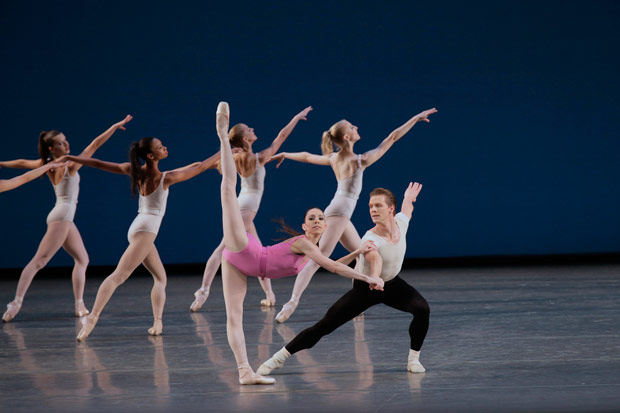
© Paul Kolnik. (Click image for larger version)
New York City Ballet
21st Century Choreographers (20 April): Estancia, Pictures at an Exhibition, Everywhere We Go
Classic NYCB I (23 April): Bournonville Divertissements, Moves, Tchaikovsky Pas de Deux, Symphony in Three Movements
★★★★✰
New York, David H. Koch Theater
20, 23 April 2016
www.nycballet.com
davidhkochtheater.com
Springtime at Lincoln Center
For followers of ballet, the past two weeks have been whiplash-producing, what with the whirlwind visit by Miami City Ballet followed by the start of the New York City Ballet season. No complaints here. It’s fascinating to see just how much the two companies have in common – a strong Balanchine backbone, vibrant musicality, speed – but also how surprisingly different they are. This is especially remarkable when one sees the same ballet in back-to-back performances, as was the case with Balanchine’s Symphony in Three Movements.
Last week, Miami’s Symphony was exuberant, with a moment-by-moment excitement that held the audience rapt from beginning to end. Every member of the company looked energized. City Ballet’s performance at the Saturday matinée was more uneven. The corps was less electric, and a few of the principals performed matter-of-factly. But the highs were so high that the impression, in the end, was just as strong. And what a piece it is: bold, athletic, warlike, and mysterious, all at once.

© Paul Kolnik. (Click image for larger version)
City Ballet’s Sterling Hyltin and Taylor Stanley, in particular, danced with an enormous sense of style and incisiveness. It illuminated the choreography, especially in the strange, witty second act pas de deux. They entered, one from each side, undulating one arm until they collided at the middle of the stage, fingers reaching across each other like the tentacles of an amoeba. Every pose was elongated, every shift a surprise, every twist or flexed torso magnified for maximum effect. Hyltin, who is unusually long and lean, even for a ballerina, uses her hips and head to add a saucy sophistication to her dancing. Stanley complements this with his sudden, quick shifts and elaborate politesse. Their dancing took the ballet to a higher level.
The afternoon had begun with a performance of Bournonville Divertissements, a series of excerpts from three ballets by the nineteenth-century Danish choreographer August Bournonville. It was staged for the company in 1977 by the Danish-born teacher Stanley Williams. It’s too bad the company now performs the first excerpt, a wonderful ballabile from the first act of Napoli, in front of a drab, gray backdrop meant to evoke a nineteenth-century ballet studio. Where are the sunshine and the sea air, so vividly evoked by the Neapolitan song Io te voglio bene assaje, which runs through the ballet’s score?
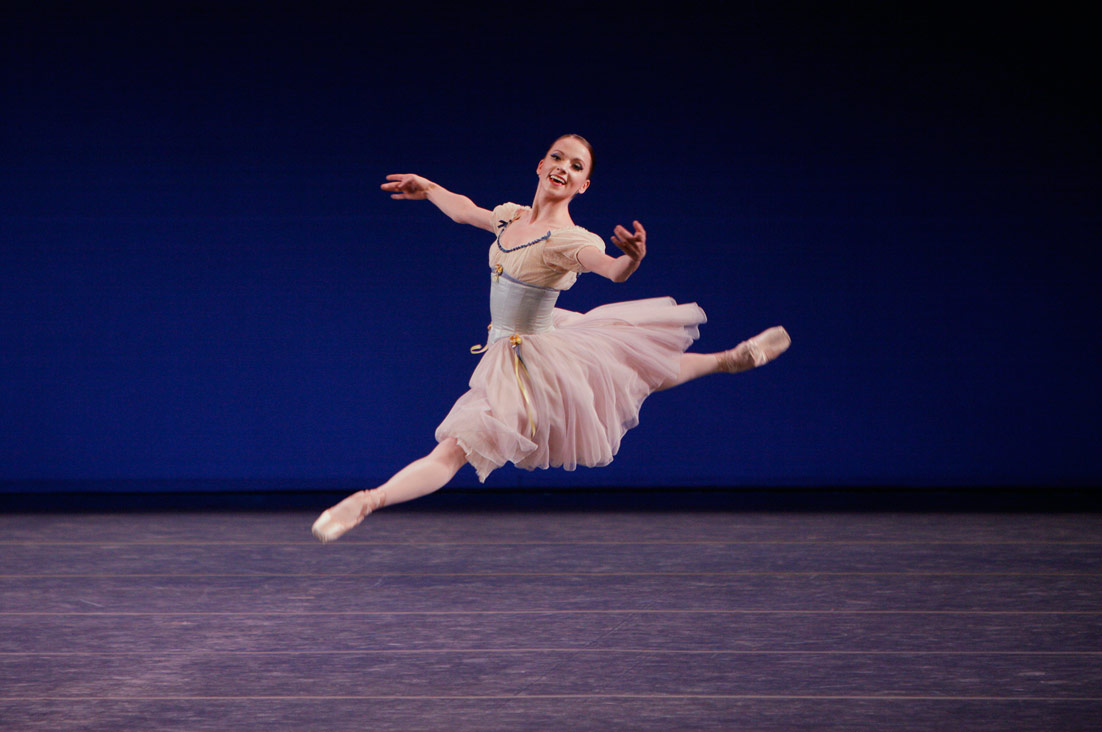
© Paul Kolnik. (Click image for larger version)
Nevertheless, Bournonville’s choreography – filled with beaten jumps and explosive leaps complemented by soft, rounded, arms and relaxed shoulders – is buoyant enough to produce its own glow. It all looks so devilishly hard, and, at the same time, so open and un-forced and, somehow, joyful. Troy Schumacher was a charming and attentive suitor in the ballabile; his partner Erica Pereira made less of an impression. In the flirtatious pas de deux from Flower Festival in Genzano, Zachary Catazaro danced with ardor, soaring through the big jumps and showering attention on his partner, Abi Stafford, who was far less effusive (and a little sketchy in her dancing). Anthony Huxley stole the show in the pas de six, drawn from Napoli and Abdallah and set, incomprehensibly, against a view of the rooftops of Copenhagen. The cleanness of his dancing was, as always, astonishing. But Indiana Woodard, with her smiling eyes and round shoulders, looked the most at home in Bournonville’s warm, lilting style. (I had the passing thought that this ballet would look great on Miami City Ballet.)
Between these two works, the dancers performed Moves, by Jerome Robbins, and Tchaikovsky Pas de Deux, with a début by Ashly Isaacs. Her partner was Chase Finlay, finally back this season from a long injury. Isaacs gave a solid performance, which will doubtless grow more playful and more daring over time. Moves has the distinction of being Robbins’ only ballet to be performed in silence. He made it in 1959 for his touring group, Ballets:USA. It has an experimental feel, as if Robbins had decided to place a spotlight on all the conventions of balletic presentation, partnering, and Balanchinean rigor. (I could be wrong, but it seems to me there are references to Agon, which premiered just two years earlier.)
The dancers start out in a line across the front of the stage. A few of them pivot into second position – legs apart – so that they are standing at a diagonal to the rest. Then one of them bends forward, throw her arms into the air, and runs off. This is repeated by several others. There’s a long pas de deux, performed here by Adrian Danchig-Waring and Ashley Hod, in which, the man presses down on the woman’s arms as she sits in a split on the floor, then slowly places her hands behind her back, and finally pulls her head back, manipulating her like a mannequin. In another section, three couples – two men, two women, and a man and a woman – partner each other, echoing each other’s movements. The only accompaniment is the dancers’ stomps and the occasional slap on the floor, plus the inevitable coughing from the audience. It’s a curious and original work, if perhaps a little over-long.

© Paul Kolnik. (Click image for larger version)
Earlier in the week, on April 20, the company gave a performance of three ballets made for the company by today’s busiest trio: Christopher Wheeldon, Alexei Ratmansky, and Justin Peck. Estancia, Wheeldon’s take on Alberto Ginastera’s 1943 ballet, is like a gaucho version of Agnes de Mille’s Rodeo. The young “country girl,” Tiler Peck, is a champion horse-tamer. Tyler Angle, the “city boy,” is instantly smitten. They tame a few horses together, and then fall in love. It all ends with a big hoe-down – sorry, malambo – and everyone lives happily ever after. Wheeldon made Estancia in 2010, before Alice in Wonderland and American in Paris, and you can see him teaching himself how to tell a story coherently and clearly, without distractions. The characters and plot are rather clichéd and the “country girl” lacks the verve of the cowgirl in Rodeo, but there are some nice touches: the kicking, moon-walking choreography for the horses, a lovely ensemble for the women planting seed, and the square-dance-like finale. (The swooning pas de deux is echt Wheeldon: fluid and laced with rapturous lifts.) The backdrops of dusk on the pampas, by Santiago Calatrava, are beautiful. But to make Estancia more convincing the company needs to dance it more vibrantly, more like a piece of musical theatre and less like a pretty concoction. The dancers seem almost embarrassed by it.

© Paul Kolnik. (Click image for larger version)
One of the most striking things about Pictures at an Exhibition (the Ratmansky) and Everywhere You Go (the Peck) is precisely this: the fervor they unleash. Both reveal new aspects of the dancers. In Pictures, their theatricality and willingness to throw themselves into wild, folky, earthy movement. (And to be funny.) And in Everywhere We Go, a degree of clarity and sharpness that allows you to see the choreography before you almost like a drawing on a page. The opening, in which three men dance with their shadows – a counterpart lying on the floor – leaves an indelible impression. The fact that the music (by Sufjan Stevens) is blaring and sentimental and that the ending is overly drawn out doesn’t dilute its effect.
Which brings us back to the original point, which is that New York is a good place to be in springtime.












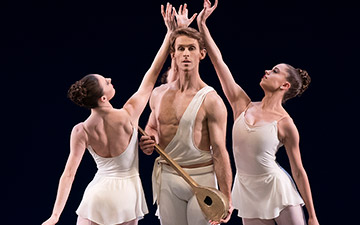
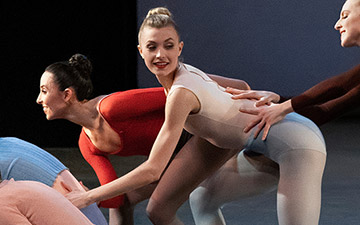

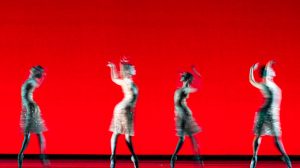

Thanks for this terrific and evocative review. This was the performance I wanted to attend, but could not make it to NY.